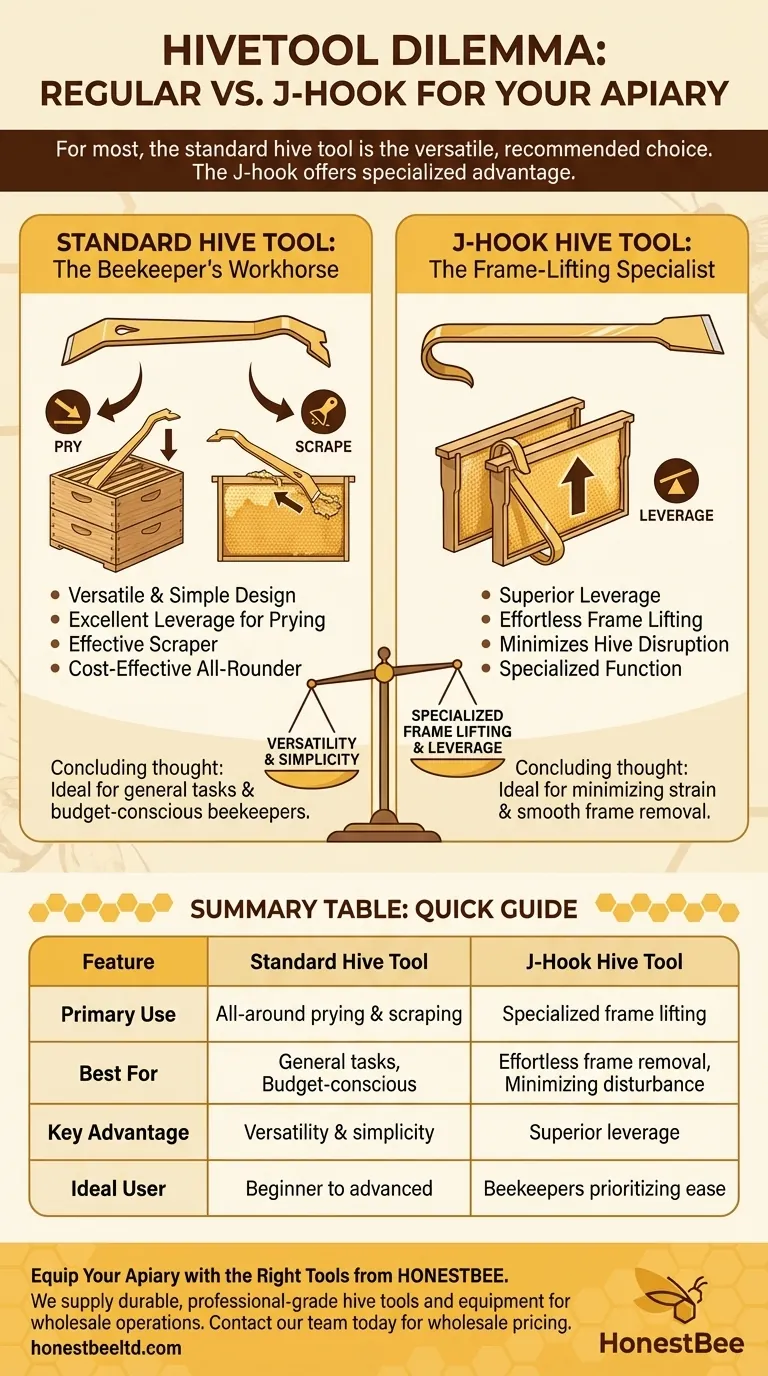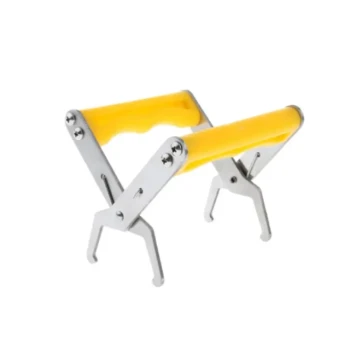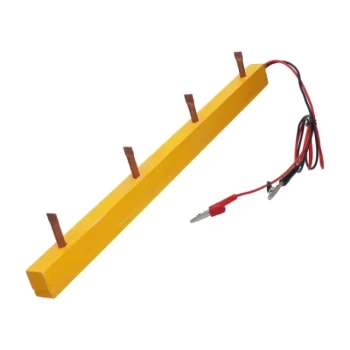For most beekeepers, the standard hive tool is the recommended choice. It is a versatile, inexpensive, and readily available multi-tool that excels at the two most common tasks in beekeeping: prying apart hive bodies and scraping away unwanted propolis or wax. While the J-hook tool offers a specific advantage, the standard tool's simplicity makes it the ideal starting point.
The core difference lies in their specialization. The standard hive tool is a general-purpose pry bar and scraper, while the J-hook tool is specifically engineered to provide superior leverage for lifting frames, often at the expense of some all-around utility.

The Standard Hive Tool: A Beekeeper's Workhorse
The standard hive tool is the most common tool you'll find in a beekeeper's kit for a reason. Its design is simple, effective, and has been proven over decades of use.
What is a Standard Hive Tool?
It is essentially a small, flat crowbar. One end is long and flat with a sharp, beveled edge, while the other is shorter and bent at a right angle.
Core Functions: Prying and Scraping
The long, flat end provides excellent leverage for prying apart hive bodies and supers that bees have sealed together with propolis. The curved end is a highly effective scraper for removing wax and propolis from frames and hive components.
Its Primary Advantage: Simplicity
This tool is the definition of a multi-purpose workhorse. It's used for separating boxes, lifting frames, scraping surfaces, and even prying out old nails. Its straightforward design makes it intuitive to use from day one.
The J-Hook Hive Tool: The Frame-Lifting Specialist
The J-hook tool is a modification of the standard design, created to solve one specific challenge with more elegance and less effort.
What is a J-Hook Hive Tool?
This tool is typically longer than a standard tool and features a distinctive "J" shaped hook on one end. The other end is a familiar flat, beveled scraper.
The Power of Leverage
The J-hook is its signature feature. You slide the hook under the ear of a frame and use the top of the adjacent frame as a fulcrum. This gives you exceptional leverage to lift the frame straight up without jarring it or rolling bees.
Why This Matters
Lifting a heavily propolized frame can be difficult. The J-hook makes this process effortless, which is especially useful for beekeepers who need extra strength or want to minimize any potential damage to the woodenware.
Understanding the Trade-offs
Neither tool is objectively "better" in all situations. Your choice depends entirely on which task you want to optimize for.
Ease of Use vs. Specialized Function
The standard tool is more intuitive for general prying and scraping. The J-hook excels at its one primary job—lifting frames—but can feel slightly less agile for other scraping tasks compared to the simple bent end of a standard tool.
Frame Handling
This is the J-hook's domain. It provides a clean, vertical lift that is difficult to replicate with a standard tool, which often requires more prying and wiggling that can disturb the colony.
Versatility and Cost
The standard tool is generally cheaper and considered the indispensable all-rounder. Many experienced beekeepers own both but would choose the standard tool if they could only have one.
Making the Right Choice for Your Goal
Your primary need should dictate your first purchase. Many beekeepers eventually find value in owning both.
- If your primary focus is simplicity and budget: Start with the standard hive tool, as it handles every essential task effectively and is the most cost-effective option.
- If your primary focus is hand strength or minimizing hive disruption: Choose the J-hook hive tool, as its superior leverage makes lifting sticky frames significantly easier and smoother.
- If you are an established beekeeper looking to optimize your workflow: Add the tool you don't currently own to your kit to have the perfect instrument for every specific situation you encounter.
Ultimately, selecting the right hive tool is about matching its design to your personal beekeeping style and needs.
Summary Table:
| Feature | Standard Hive Tool | J-Hook Hive Tool |
|---|---|---|
| Primary Use | All-around prying & scraping | Specialized frame lifting |
| Best For | General beekeeping tasks, budget-conscious beekeepers | Effortless frame removal, minimizing hive disturbance |
| Key Advantage | Versatility and simplicity | Superior leverage for sticky frames |
| Ideal User | Beginner to advanced beekeepers | Beekeepers prioritizing ease on hands and hive |
Equip Your Apiary with the Right Tools from HONESTBEE
Choosing the correct hive tool is crucial for an efficient and gentle beekeeping practice. At HONESTBEE, we supply durable, professional-grade hive tools and beekeeping equipment to commercial apiaries and distributors through our wholesale-focused operations.
Let us help you optimize your workflow with the right gear. Contact our team today to discuss your equipment needs and wholesale pricing.
Visual Guide

Related Products
- Ergonomic High Visibility Plastic Frame Grip Handles
- Ergonomic Two Person Foldable Hive Lifter
- HONESTBEE Wooden Bar Copper Prong Wire Embedder for Battery Operation
- Professional Pneumatic Wire Embedder for Beehive Frames
- Wooden Bee Brush with Double-Row Horsehair Bristles
People Also Ask
- What is a beekeeper tool? The Essential Hive Management Lever for Apiaries
- What precautions should be taken when using a sharpened hive tool? Maximize Efficiency While Staying Safe
- How is the standard hive tool used in beekeeping? Master Essential Hive Management
- What is the recommended method for pushing multiple frames back into place? Master the 2-4 Frame Technique for Bee Safety
- Why are beekeeping tools important for hive management? Ensure Colony Health and Safety



















